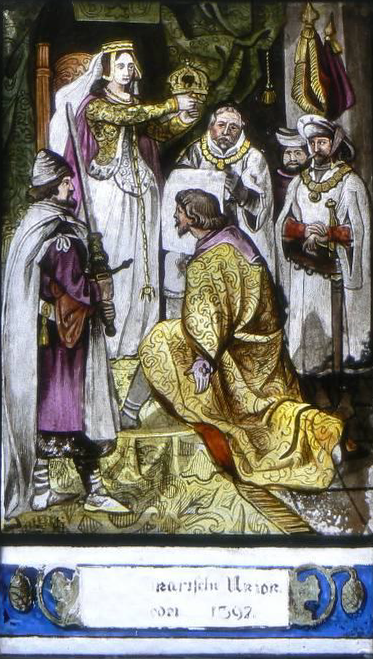This Week in History recalls memorable and decisive events and personalities of the past.
29th April 1521 – Swedish War of Liberation: Swedish troops defeat a Danish force at the Battle of Västerås

Gustav I of Sweden in Västerås, 1527. Watercolor reproduction from 1722
The countries of Scandinavia have always had close ties, politically, economically and, for the most part. linguistically (except Finland). For a time, however, they were not just close, but in fact united under one monarchy in a union called the Kalmar Union.
The Kalmar Union, c. 1400 [Ssolbergj, https://commons.wikimedia.org/w/index.php?curid=5729889]
In the late 1300s, the Baltic Sea was a bustling region of trade. Tar, furs, hemp, iron, potash, wax, fish and salt flowed across its waters, an exchange that created a hive of economic activity.
This trade came to be dominated by a league of merchants and cities, known as the Hanseatic League. Originally founded in the north German city of Lubeck, this league upended the normal feudal order by making the non-nobility extremely powerful. By the early 1400s, the power of the Hanseatic League was felt all along the northern coast of mainland Europe, from the Netherlands to what modern-day St Petersburg in Russia.

Northern Europe in the 1400s, showing the extent of the Hanseatic League [Droysen/Andrée – Plate 28 of Professor G. Droysens Allgemeiner Historischer Handatlas, published by R. Andrée, 1886, https://commons.wikimedia.org/w/index.php?curid=17108274]
The nobility of Scandinavia became increasingly worried about the power of this merchant trade empire. To counter this, the nobility of Denmark, Norway, and Sweden were united in 1397 by King Eric of Pomerania, who, for a time, co-ruled with the true mastermind of the Union, Margaret I of Denmark, his great aunt.

An allegory of the inception of the Kalmar Union: Queen Margaret crowning Eric of Pomerania king of Norway, as depicted in a stained-glass window at Pena Palace, Portugal
The treaty uniting the three kingdoms promised ‘everlasting union’, and that ‘all three realms should exist together in harmony and love, and whatever befalleth one, war and rumours of war’.

Eric of Pomerania
At the time, the Kingdom of Denmark ruled Iceland, the Faroe Islands, and the most northern part of Germany, while Sweden ruled much of modern-day Finland, effectively making the Kalmar Union a uniting of all the nations that would one day become modern Scandinavia.
For its first few decades, the union was fairly harmonious, and effectively blocked the power of the Hansa. Tensions however began to bubble away under the surface. Denmark had been the leading power in uniting the three kingdoms, and Denmark at this time had the largest population and strongest economy. As such it played an outsized role in the union. At the same time, the king, who was usually based in Denmark, sought to centralise his realm and grow his power, in the fashion of the monarchs in other parts of Europe at that time.
This was met with significant opposition, mainly from the nobility of Sweden, who hated the extra taxes levied by the Danish kings to fund their war on the Hansa.
In 1434, the Engelbrekt rebellion broke out in Sweden against the rule of Eric of Pomerania.

A monument to the rebellion, in Stockholm [Mats Halldin 14:12, 2 March 2007 (UTC), https://commons.wikimedia.org/w/index.php?curid=1733748]
After some battles between the Danes and Swedes, the Danish were expelled from Sweden.
They would not be gone for long, and only a few years later would resume their rule over Sweden.
During the 1400s, Sweden fell into and out of the Kalmar Union on a number of occasions. During the periods when Sweden was out of the union, it battled with Denmark for control of Norway.
By the late 1400s, the Danes had managed to establish some sort of dominance, until the beginning of the reign of Christian II of Denmark.

Christian II
When Christian was crowned king, pro-unionist nobles in Sweden took the opportunity to eliminate some of their rivals in the Swedish nobility and carried out a massacre of around 100 nobles on charges of heresy. This event became known as the Stockholm Bloodbath.
A son of one of the men executed, called Gustav Vasa, fled Stockholm and began rallying support from the countryside. The tale of the unexpected, and in the view of many, unjustified executions developed significant support for a rebellion.
So began the ‘Swedish War of Liberation’.
Between 1521 and 1523, Vasa led a rebellion which tore Sweden apart.
On 29 April 1521, the rebels won a victory over the Danes at the Battle of Västerås.
However, the rebellion went on inconclusively until the Hanseatic League joined the war on the side of Sweden in 1522.

Entry of King Gustav Vasa of Sweden into Stockholm
In 1523 Christian II was overthrown by a Danish uprising and the war effectively ended in favour of Swedish independence. In 1524, the new Danish king signed a treaty with Vasa, formally ending the war.
In the years after, Vasa would lead newly independent Sweden’s severing ties with the Catholic Church, and its becoming one of the most important Protestant countries in Europe.
If you like what you have just read, support the Daily Friend

